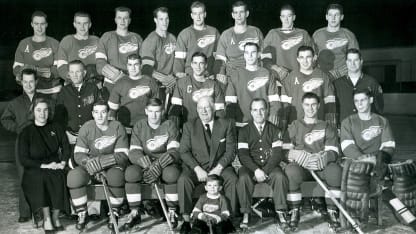When the Norris family was looking for a new staff member, there was one question during the job interview that often caught the applicants off guard.
"Can you skate?" James Norris Sr. always asked when filling a position at the family's Lake Forest, Ill. estate.
Norris was first woman to have her name inscribed on the Stanley Cup
As president of the Red Wings, she was also the first female to run an NHL team

By
Bob Duff @asktheduffer / Special to DetroitRedWings.com
You see, the interest that the Norris family took in the game of hockey went far beyond their ownership of the Detroit Red Wings.
There was a patch of ground on the property that was hosed down in winter to create an outdoor rink. Each member of the Norris family also loved to play hockey.
Papa James, who'd once briefly toiled for the famous Montreal AAA, the club that was the first winner of the Stanley Cup -- the club's winged wheel symbol was the basis for the Red Wings logo -- and his four children all strapped on the blades and happily chased the puck around the ice with their sticks.
Both the Norris boys, Jim Jr. and Bruce, would partake in these family hockey games, and so would the two Norris girls, Eleanor and her little sister Marguerite.
"I was the youngest, so they made me the goaltender," Marguerite Norris explained to the Associated Press in 1952. "I was the target."
The occupation of stopping the puck, of building a wall in front of the net, must have seemed foreign to Norris, and not because of her gender. In years to come, she would gain a legacy as someone who toppled walls, who broke through barriers.
On Dec. 4, 1952, James Norris Sr., who'd owned the Red Wings franchise since 1932, died at the age of 72. When his will was probated nine days later in Waukegan, Ill., it was revealed that he designated his youngest child, daughter Marguerite Ann, to assume the day-to-day operations of the Red Wings.
The next day, she was installed as president of the franchise. It was a history-making moment in so many ways. Marguerite Norris became the first female to operate a team in National Hockey League history.
At the age of 25, she was also the youngest president of a professional sports franchise.
"Like all members of the Norris family, she is a great sports enthusiast," former Red Wings general manager Jack Adams told the Detroit Times.
Marguerite Norris was adept at golf, tennis and yachting, but hockey was always her first love.
"I guess it's my favorite because it was the first sport I ever heard about," she once explained. "It certainly is the best professional spectator sport."
Upon learning she'd been designated to take over the team, the first thing Marguerite Norris did was arrange a one-on-one meeting with Adams in Chicago.
A hockey lifer who'd been general manager of the Wings since 1927, Adams had just guided the Wings to the 1951-52 Stanley Cup, the team becoming the first in NHL history to go 8-0 in the playoffs.
"You want me over there?" she asked Adams.
"Sure I do," was his response.
The two shook hands and Norris made a solemn vow to Adams.
"We'll keep the Wings up there," she said.
She would do everything in her power to hold up her end of that promise. While Adams handled the hockey operations, Norris took care of the business side of the team.
Her brothers Bruce and Jim already held ownership shares in the Chicago Blackhawks, but it soon became clear why James Norris Sr. had designated his youngest daughter to take over the Wings. She was most qualified to take on the job.
Norris, a tall woman who stood 5-foot-11, graduated from Smith College in Northampton, Mass. with a degree in business administration. She'd worked in New York City for Dun and Bradstreet.
"She was a good businesswoman," former Wings defenseman Marcel Pronovost told the CBC in a 1994 interview.
Current Wings owner/secretary-treasurer Marian Ilitch has referred to Norris as "the first lady of hockey," and like Marian Ilitch, Marguerite Norris was a very hands-on owner whose positive impact served both the betterment of the team and the NHL as a whole.
Norris championed the cause of broadcasting games on television to her fellow owners, seeing it as the future of the game and a lucrative revenue stream. She sought to try to bring more stability to the league by loosening the control teams had over players and allow for easier movement to help create better competitive balance.
Naturally, these ideas were not welcomed with open arms by the old boys network of NHL owners.
Norris was permitted to attend NHL board meetings but that was about as far as the owners of the other five teams were willing to acquiesce.
"I'd be allowed to sit at meetings but never allowed to vote," Norris explained to the CBC in 1994.
Adams filled the role of Detroit's governor, but Norris devised a series of secret hand signals to allow her to let Adams know how she wanted him to vote.
She sought to make Olympia Stadium a more comfortable place for female fans. The facility was spruced up, given a fresh coat of paint and kept spotlessly clean. Ushers were outfitted in bright new uniforms. Chicken wire was installed above the dasher to offer protection to fans, both from flying pucks and bodies spilling over the boards.
"She was just down to earth," Gordie Howe once remembered, "She was totally different, which made us very comfortable."
In an era when players were considered nothing more than chattel, Norris sought to make them feel that they were both welcome and appreciated, even when things didn't go Detroit's way.
"We were in Boston (in 1953) and we lost in the playoffs that year," Red Kelly remembered. "It was Easter. "We traveled by train in those days and when we came back to our berths, there was a big chocolate Easter rabbit sitting in all the guys' berths."
On April 16, 1954, when Tony Leswick scored at 4:29 of overtime to give the Wings a 2-1 win over the Montreal Canadiens in Game 7 of the Stanley Cup final, the outcome created an NHL first. As president of the Red Wings, Marguerite Norris would be the first woman to have her name inscribed on Lord Stanley's mug.
Earlier that season, Bruce Norris had divested himself of his interests in the Blackhawks and along with his sister, bought out Arthur Wirtz's ownership share in the team and Olympia Stadium and became sole owners of the Red Wings. Bruce Norris replaced Adams as governor of the Wings.
In 1954-55, the Wings would again take the Stanley Cup from Montreal in a seven-game final series and Marguerite would win her second Stanley Cup as president of the team.
On Oct. 28, 1955, the Red Wings announced that Marguerite was relinquishing her duties as team president to her brother Bruce. She would assume Bruce's title as vice president and continue to sit on the board that ran both the Red Wings and Olympia Stadium.
She was living in New York and found it difficult to maintain her business interests there as well as stay on top of the day to day operations of the Wings.
During her three years at the helm, the team won two Stanley Cups and finished in first place all three seasons. Norris had also turned the Wings into a more profitable operation.
Today, there are 15 women recognized with a Stanley Cup inscription, six of them earning those etchings with the Red Wings organization.
Marguerite Norris, who died in 1994, will always be the first. And because of that, those who knew her the best believe that her pioneering efforts make her worthy of another rare honor -- induction into the builders' section of the Hockey Hall of Fame.
"She won two Stanley Cups and she was running the club as far as the ownership," Kelly said. "There are people in the Hall of Fame who've never won the Stanley Cup.
"So I would say that yeah, she has very good rights and credentials to be there."


















































